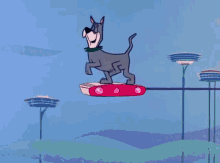1 SIMPLE IDEA: The case for looking foolish to improve
It's a critical tool to learn, push through barriers and move the needle in a profound way with endeavors we pursue.
Warmup
He made it look so easy — the young man next to me on the treadmill at the gym.
I’d been eyeing him as he pivoted laterally on the machine and started side-stepping on the moving belt with elegance and power.
Great idea, I thought. Recently, I’d begun weaving lateral movement into my workouts as a way to strengthen muscle movement in all planes (versus just forward and backward, such as when I run.)
If this guy, who looked like a football linebacker, could move with such dexterity — surely I could? Afterall, my 85-year-old mother-in-law was hitting the punching bag in the other room. Yep, that’s right. More on that in another newsletter.
So, without another thought, I turned sideways while moving at a 3.2 mph clip.
That sound you just heard? “Ruh-roh.” Yep, that’s me in the GIF above.
Post
The Greek Stoic philosopher Epictetus pondered the will of humans and importance of distinguishing what we can control from what we can’t. One widely shared thought: “If you would improve, be content to be thought foolish and stupid with regard to externals.”
Research shows adopting this mindset is critical if we want a chance of success in a new endeavor — new job, sport or skill.
Some of you may know Stanford psychologist Carol Dweck’s book Mindset: The New Psychology of Success where she champions the idea that we can flourish more in our endeavors if we believe our abilities can be cultivated through hard work — versus simply being born with certain gifts.
There’s also an intriguing concept called “productive failure” put forth in a new book published late last year by learning scientist Manu Kapur, suggesting that constructive failure can help us learn more deeply. I intend to read it and learn more.
The best organizations actually champion ideas that may seem foolish, research shows. One quote I like:
“Ideas might well be foolish, but if they’re right, they’re going to be genius,” said William P. Barnett at Stanford’s Graduate School of Business. “Organizations that create lots of foolishness also create a lot of genius.”
In other words, making room for some foolishness is how you move the needle in a profound way.
But looking foolish can be deeply uncomfortable, particularly as we age, are accustomed to calling the shots — and perhaps harbor the illusion that we need to exude dignity.
In my first obstacle race in 2018 at New York’s Citi Field, I attempted to climb a 17-foot rope and dropped like a sack of flour from 10-12 feet up in the air into a crumpled heap on the mat below. I was 46-years-old at the time.
I didn’t need a video to show me. I knew I looked dumb. Really dumb.
Back then, I wasn’t used to feeling this way. I nearly left the race and slinked off to my car.
But, in one of those turning point moments you can’t immediately recognize for its importance, I didn’t. And that decision made all the difference in how my life has unfolded ever since. Last year, I completed my 56th race. (More in my book, Not Too Late.)
By getting OK looking foolish, I learned to climb that rope in a gym filled with people young enough to be my children. I fell off monkey bars repeatedly, until I eventually got real instruction by a little girl on a playground.
Learning, unlearning, relearning. It’s not just about exercise.
For instance, learning to be comfortable with emotional and intellectual discomfort gave me the nudge to take a job in a new industry working with technology and AI. I wasn’t scared not to know things, or be the wisest voice in the meeting. I knew I could learn.
Cooldown
Now, back to that treadmill.
As I picked myself off the floor, the very obvious thought-bubbles of other runners floating above me (OMG, has she never used a treadmill before?), I refrained from fleeing to the locker room to lick my wounds.
Instead, I dragged my pride back onto the still-spinning treadmill, lowered the speed and tried again. And again. And again.
Until finally, the motion clicked. And I could (almost) mimic the motion of the linebacker, who gave me a nod of approval.
When my workout was done, I walked into a back room they called “The Vault” (The room where my mother-in-law had been throwing jabs.) And I climbed the 25-foot rope hanging there to the rafters. I didn’t fall.
Thanks for reading. As always, find something you love. Dig in. Stick with it when things get hard.
And be OK looking a little foolish.
Wendy




My weekly krav maga class is for beginners. I’m 53 and had a HS freshman correcting my movement. I could be silly and not want to listen or I could learn.
nothing looks dumber IN FRONT OF OTHER PEOPLE than double-faulting twice or more in a game. but holding back with a wimpy serve means you never get competitive since anybody good can do anything they want with it.